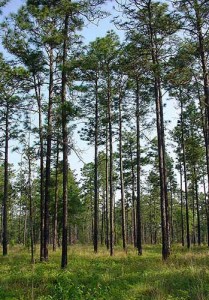By Sofia Maia-Goldstein, Policy Intern
America’s Longleaf Restoration Initiative (ALRI), a group of private and public partners that seeks to restore and conserve longleaf pine ecosystems in the southeast U.S., made strides in the political world last week.
Addressing the loss of 90 million acres of longleaf forests from its original range, American Forests and a diverse number of stakeholders, including conservation and forestry groups, private landowners, and multiple state and federal agencies, have come together to work towards restoring millions of acres of longleaf forest.

In the past five years, 1.38 million acres of newly planted trees have helped reverse the decline of the species, which ranges from Virginia to Texas. In celebration of progress, the initiative held a panel, featuring Secretary of Agriculture Tom Vilsack, who moderated a small group of landowners, a state forester, industry and Longleaf Partnership Council members to discuss the success to date as well as how to sustain efforts in years 6-10. Following the panel, a reception was hosted by Natural Resources Conservation Service Chief Jason Weller and U.S. Forest Service Chief Tom Tidwell.
In addition to celebration, constituents and conservation organizations visited Congress to address necessary funding for reforestation programs to ensure the reestablishment of longleaf continues on an upwards trend.
Although the Farm Bill provides mandatory funding for many of these programs, the FY15 Agriculture Appropriations bill currently proposes a reduction to a number of programs, including the Environmental Incentives Program, the Conservation Stewardship Program and the regional Conservation Partnership Program. When discussing FY15 with congressional staffers, the ALRI advocated for the FY12 levels for these programs, as funding has decreased from that appropriated level since.
Addressing wildland fire and budgeting problems in the Departments of Agriculture and the Interior will also be critical in maintaining longleaf pine forests and ensuring money from associated programs is not shorted because of a “borrowing effect” from a lack of funds for fire suppression. Proper funding for these programs would mean quicker and more efficient restoration along with a number of economic, environmental and social benefits for communities involved.
These precious forests support a large amount of wildlife species, offer high quality timber opportunities, provide a buffer zone for military installations, and restore historical integrity to the land. American Forests has recognized the critical importance of these pines by taking action on the ground. Through several programs, we have helped plant more than five million longleaf pines since 1992. These new habitats continue to offer a home for endangered species including the gopher tortoise and the red cockaded woodpecker.
Together with support from several regional and federal agencies, constituents and landowners, American Forests will continue to advocate for the reforestation of longleaf pine and the benefits the species brings to the southeastern U.S.
Be sure to check out Loose Leaf later this week for a post from Communications Intern Caroline Brooks and me about our experience with longleaf restoration advocacy on Capitol Hill!